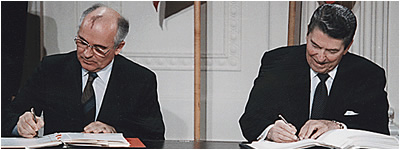|
An awkward situation resulted as
the Soviet Union and the United States refused to retreat to their corners -
fearful that the other might try to take over their war gains. The United
States, with reduced troop number in Europe but with its newly acquired
nuclear weapon in hand, defied Russia to come any further west, or the
meddle in the affairs of the liberal democractic governments there. Likewise,
Russia defied the United States to intervene as the Russian military
occupation replaced the governments in the eastern sector with Stalinist
regimes.
Soon armed with its own
nuclear weapon, the Soviet Union knew that the United States could not
challenge it in its zone of influence - any more then Russia could challenge
the United States in its zone. By 1950, a stalemate had settled in.
At this point, the
entire western world, indeed the whole world, was involved in an on-going
test of strength (the Cold War) between these two military giants. The
United States claimed to represent the older legacy of European liberal bourgeois
democracy and capitalism (intermixed with its American Protestantism). Soviet
Russia claimed to represent the new wave of Marxist scientific socialism or Communism (hierarchically controlled industrialism
- a system that Marx
would never have recognized). As this military standoff became also a moral
standoff, the world looked on in horror wondering what might be the outcome.


In short, in those 50
years the position of movers of western history had shifted from its old
center in western Europe to its periphery: to America in the west and to
Russia in the east. Europe proper was caught in the middle, by sheer
necessity having to ally with one or the other power - willingly or
unwillingly.
Human Growth:
The theme that
marks this period is growth - incredible growth or development in the
human picture. During the second half of the 20th century the world was
treated to a period of peace that permitted both the rapid rise in the size
of the human population and in the equally rapid growth in its accumulated
wealth. And along with this numeric growth went an incredible growth in the
quality of life - particularly in terms of the individual's ability to live
in a vastly wider realm of personal freedom and personal economic
opportunity.
Dynamics of the Cold War: To be sure, the
dark clouds of Cold War hung over the world for most of this "peaceful"
period. But the Cold War between Russia and the United States remained stalemated in
terms of direct confrontation between the superpowers for all but the last
ten years of this period (when in the late 1980s the Russian political-economic
system built under Stalin collapsed).
Living within the
American sphere of influence and receiving vital industrial encouragement
from America as a buffer to an expansionistic Russia, western Europe during
this half-century enjoyed a wonderful peace under which it could rebuild
itself. Indeed, without the incentive of the Cold War, it is unlikely that
western Germany (as well as Japan in east Asia) would have seen such a quick
post-war return to both national freedom and prosperity.
Even eastern Europe,
though under Soviet dominance and industrial exploitation during most of
this period, also experienced a measurable amount of growth and stability,
though much less extensively than in the west. In the end the slowness of
the eastern growth in comparison to the west's growth proved to be the
undoing of Stalinism in the east - even within the Soviet Union itself.
Though, there were
wars in and around the rest of the world - as for instance in Vietnam, in
which the Cold War mentality drew the United States into an ill-fated intervention
which ravaged Vietnam and backfired on the United States. But these conflicts
generally remained quite limited in scope, in part because the superpowers
would intervene to create a stalemate that served to prevent the conflict
from escalating into a larger direct Russian-American confrontation. The stalemate, of course, also served to force peace upon the local combatants.
Certainly the
superpowers were at times blamed for being the cause, or at least the
worsening, of local conflicts. But in fact, a fair appraisal of history
reveals that the actual level of conflict in our world during this era was
greatly reduced from what it might have been because of the Cold War
diplomatic stalemate (with the important exception of Vietnam, where
America's president Johnson determined to involve his country in direct,
unilateral military action). Indeed, in those conflicts in which the
superpowers showed little interest in controlling the outcomes, violence
achieved historically high levels. And when the Cold War ended in the late
1980s, violence returned even to Europe itself when there were no longer
competing superpower interests to force management of local conflicts.

Overall, the Cold
War was responsible for much of the positive development in and around the
rest of the world. Most importantly, the competition to show off the
respective American and Russian social systems caused these two countries to
busy themselves in developmental work which aided enormously in the
creation of important industrial infrastructure in the industrially emergent world of Asia, Africa and Latin America.
In the competition
between the superpowers they put their respective accomplishments before the
world as a choice: the rapid rags-to-riches rise of the Russians after
the second World War through its tightly organized social system - versus the quite
apparent wealth-for-everyone accomplishments of the American free-consumer
system. Though the Soviet system was quite attractive at first (the 1960s)
to those Asian, African and Latin American societies which hoped to
duplicate the Russian rapid rise to power, in the end it was the consumer
society projected by America that won the day - even in Russia itself. By
1990, America had clearly won the Cold War through its sheer ability to
create greater wealth. It literally spent the Russian system to death.
|
![]()